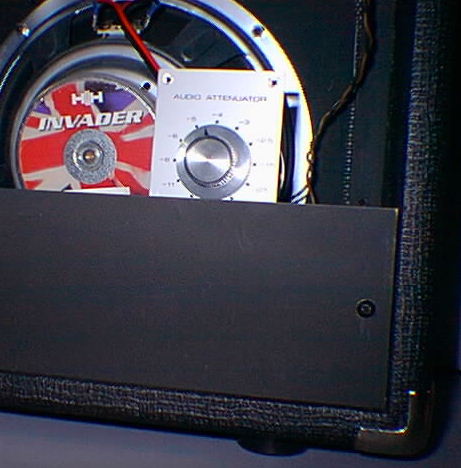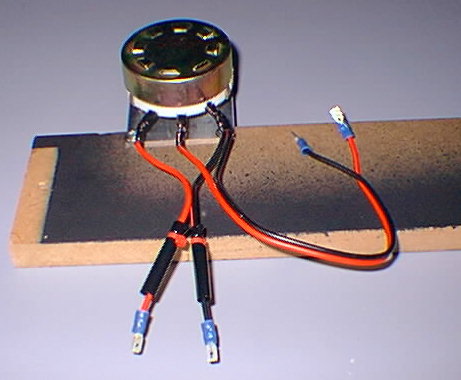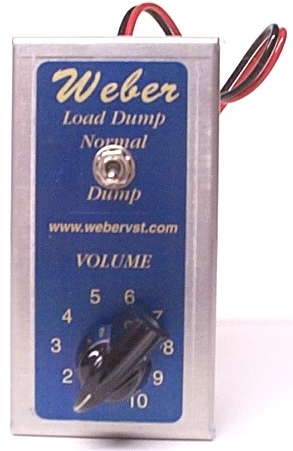Home (amp tone and effects placement)
Using a Wall-Mounted Speaker Attenuator as a Guitar Amp Power Attenuator
This approach would probably be fine if the amp expects 4 ohms and the speaker and wall attenuator, throughout the attenuator's range, aren't significantly less than 4 ohms. I ran an 8 ohm 15W tube amp for awhile into a 5-ohm wall attenuator with great results for an hour. It's best to have an amp with several ohmage settings, and measure the combined attenuator and speaker throughout the attenuator's range. I think a slightly higher ohmage load is acceptable for a tube amp, but check with techs online. It didn't obviously color the sound. It didn't get warm.
Consider repackaging this in a stompbox format, with bypass switch or two levels of attenuation and also bypass.

http://www.concentric.net/~stirfry/Lpad.jpg

http://www.concentric.net/~stirfry/L_back.jpg by John Patasius
The Weber low-power Load Dump is a properly designed equivalent to the above, and about the same cost. I wonder whether its treble and bass curve sound good. I would encourage techs to design their own comparable gear, and encourage gear users to buy existing products designed for guitar.

The above picture of the Weber - Load Dump is from http://www.webervst.com/load.html.
Consider repackaging this in a stompbox format, with bypass switch or two levels of attenuation and also bypass.
Putting a Wall Attenuator after the THD Hot Plate
I did the eq/preamp/eq/poweramp/poweratten rig hookup in the store as demonstration, proof, and for practice. It produced great results, both with clearing up the preamp distortion voicing of the amp and with bringing down the speaker volume while retaining power-tube distortion. The salesman played a strat with neck pickup and I dialed through the tones -- clean, quasi-clean, various blends of preamp dist and power-tube dist. Used a big VHT Pittbull combo amp that has two 10" speakers and one 12" speaker.
The only limitation on the tone, aside from lack of speaker distortion at this level, was that the volume fine-tune control on my Hot Plate has too much upper treble when set below 12:00. 12:00 is a bit too loud for private playing; 9:00 is the right volume level but then there's too much high treble. This is not a psychoacoustic effect; mics pick it up as well and it's clearly excess upper-treble when played at the very lowest part of the range. I'm now regularly using a voltage splitter after the Hot Plate (a wall-mount speaker attenuator) so that I can keep the volume fine-tune control set to 12:00 or higher -- thus I have some control of speaker EQ, like a single conventional Tone control that just happens to be tied to a volume control, in addition to the bright and deep switches. I plan to contact THD to demonstrate my workaround and ask if the control can be made to sound right throughout its sweep.
The 8-ohm Hot Plate with an 8-ohm guitar speaker measures between 3 and 5 ohms, with an ohmmeter, depending on the settings of the Hot Plate.
The 8-ohm Hot Plate with my wall attenuator connected measures between 2.2 and 5 ohms, depending on the settings of the Hot Plate and wall attenuator.
This shows that it isn't straightforward determining whether a dummy load or attenuator is a safe load for an amp.
The Power Soak after the Hot Plate dulls the sound, while a wall attenuator after a Hot Plate preserves the sound; a good wall attenuator is designed for hi-fi transparency. I haven't broken my test amp so far, and this chaining of attenuators enables using the Hot Plate in its -16 dB setting as a continuously variable Treble control, which is exactly what the Hot Plate needs.
The VOX Valvetronix doesn't like having just my wall attenuator as a load -- perhaps too low ohms. However, one should be able to wire a load resistor in series with a (mono or stereo) wall attenuator to give the right resistance the amp wants to see -- try the resistor at either end to check for EQ impact.
In-Wall High-Power Volume Attenuators
To match power rating with your guitar amp, look for the W RMS rating per channel, and then cut that figure in half to account for the fact that the tube power amp is distorting and putting out more than its advertised wattage.
http://www.starkelectronic.com/spcfly18.htm -- various wall-mount attenuators. What is highest power RMS available? Stereo, mono? One says 100 W Mono -- is that watts peak, or W RMS? (AT-100 mono $12.95 "100 watts", AT-100 stereo $22.95 "100 watts, stereo") Product WP-1 is a stainless steel plate available for AT and WAT series.
Radio Shack - 100W In-Wall Stereo Volume Control (50W RMS per side)
This attenuator might work with a tube amp that's marketed as 25W or less. A 50W tube amp puts out too much power, more than 50W RMS. This could be good for a low-wattage stereo tube amp, or two mono tube amps, not over 25W per channel. Measure the ohms, though -- this needs to be the same as the tube amp expects, or a little higher, I think. -mh
$29.99 Catalog #: 40-987
This is a 10-step rotary control. Adjust volume in another room. All fit standard single-outlet electrical wall box.
Power Handling: ............................... 50 Watts (RMS) per Channel, 100 Watts Maximum per Channel
Attenuation: ......................................... 10 Position Control
1st Position (Fully Counterclockwise): Full-Off
2nd and 3rd Position: Attenuate 6 +/- 1 dB Per Step
4th to 9th Position: Attenuate 3 +/- 1 dB Per Step
10th Position: Full On
Insulation Resistance: .................... 100 Meg Ohm Minimum at 500 VDC
Dielectric Withstanding Voltage: ....................... 500 VAC, 1 Minute
Weight: .................................................. 14.3 oz (405 g)
Radio Shack - In-Wall Mono Volume Control (25W RMS)
This attenuator might work with a tube amp that's marketed as 12 W or less. A 50 W tube amp puts out too much power, more than 50 W RMS. -mh
I measured this unit as 5 ohms. This needs to be the same as the tube amp expects for a speaker load, or a little higher, I think.
I tried this with the Vox Valvetronix and it only worked up to a point, then the amp made farty noises when turned up past a point (using the amp's 1W setting). However, I got good results when using the 8 ohm Hot Plate and optionally putting this attenuator after the Hot Plate, except for when you turn the Hot Plate to Bypass -- then the farty noise happens, probably because this unit is only 5 ohms and the amp expects 8 ohms or perhaps higher. Each channel's speaker in the Valvetronix is 8 ohms. - mh
$14.99 Catalog #: 40-993
10 step rotary control. All fit standard single-outlet electrical wall box. Lets you adjust the volume on a speaker that is located in a room separate from the amplifier, so you can control the sound on the spot.
Power Handling: ... 25 Watt (RMS)
Attenuation: ......................................... 10 Position Control
1st Position (Fully Counterclockwise): Full-Off
2nd and 3rd Position: Attenuate 6 +/- 1 dB Per Step
4th to 9th Position: Attenuate 3 +/- 1 dB Per Step
10th Position: Full On
Insulation Resistance: .................... 100 Meg Ohm Minimum at 500 VDC
Dielectric Withstanding Voltage: ....................... 500 VAC, 1 Minute
Weight: .................................................. 7.8 ozs (220 g)
http://www.hometeam.com/rcc/cra_volcontrol.shtml -- 42 W RMS -- per channel, or total? mono, stereo?
http://www.customdistributing.com/products_vol_controls.htm -- 80 W RMS -- per channel, or total? mono, stereo?
Amptone.com ultra gear-search page